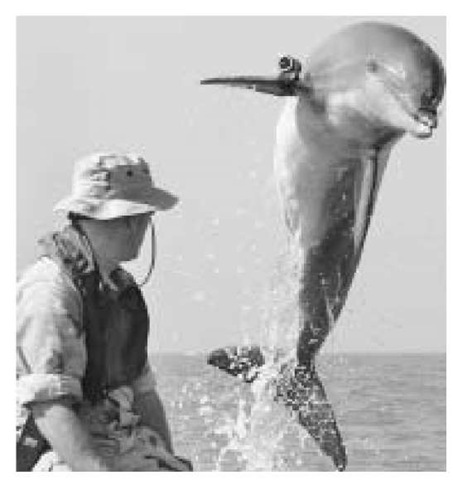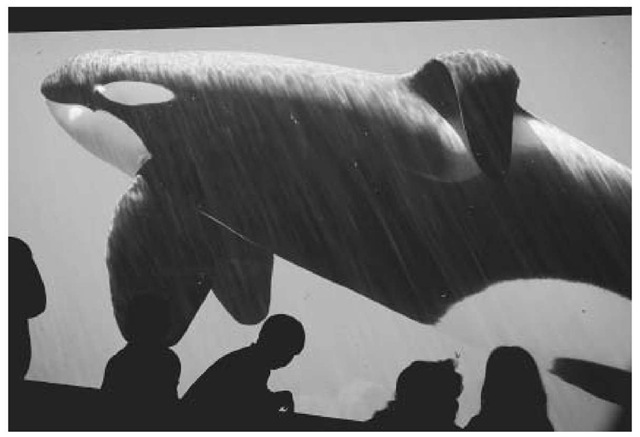Mammals are vertebrates (animals with a backbone) that share characteristics of nursing their young with milk, breathing air, having hair at some point in their lives, and being warm-blooded. Marine mammals are the species of mammals that depend on the oceans for all or most of their lives. There are about 115 different species of marine mammals. Marine mammals vary from the small sea otter to the giant blue whale.
Some of them live in groups, like dolphins, while others are solitary, like polar bears. All marine mammals share four characteristics:
• They have a streamlined body shape that makes them excellent swimmers.
• They maintain heat in their bodies with layers of fat called blubber.
• They have respiratory (breathing) systems that allow them to stay underwater for long periods of time.
• They have excretory (waste) systems that allow them to survive without drinking freshwater. Instead they obtain the water they need from the food they eat.
Marine mammals belong to three groups called orders. An order is a classification of a group of organisms, which eventually splits into species. Marine mammals are in the orders Cetecea, Carnivora, and Sirenia.
Order Cetacea
There are about seventy-seven species of cetaceans, which include whales, dolphins, and porpoises. All of these animals live their entire lives in the water. Cetaceans probably evolved from the hoofed mammals that were similar to horses and sheep. Their front legs became fins that are used primarily for steering, and their hind legs became extremely small flippers or flukes (tail fins) so as to streamline the animals for swimming. Cetaceans swim by moving their strong fluke up and down. They are grouped into two categories or suborders: Odontoceti, the toothed whales, and Mysteceti, the baleen whales.
Marine Mammals in the Military
Marine mammals have been used by the U.S. Navy for military purposes since the late 1950s. Modern day programs use Atlantic bottlenose dolphins, Pacific white-sided dolphins, and California sea lions, and training has also been conducted with beluga whales, orcas, and pilot whales. The Advanced Marine Biological Systems (AMBS) program, which supports military marine mammal programs, is located in Point Loma, California.
Dolphins can swim very fast and can maintain those speeds for extremely long periods of time. Also, dolphins use echolo-cation (sound waves) to detect prey and predators. In fact, dolphin echolocation is more sensitive than any equipment that has been developed by humans. Dolphins are particularly good at finding lost equipment on the seafloor and for locating enemy mines and torpedoes.
Sea lions have an excellent sense of hearing that allows them to detect the source of a noise, and they have vision that is very sensitive in low light. These skills make these marine mammals extremely well suited for military operations involving search and rescue.
Suborder Odontoceti The toothed whales account for about 90% of all cetaceans, including dolphins and porpoises as well as the orca (killer whale) and the sperm whale. Toothed whales hunt for prey, which they capture with their teeth. They also have one external hole called a blowhole for breathing. The toothed whales have a large brain for their size and are considered to be some of the most intelligent animals. They hunt using sophisticated echolocation, which is the method of detecting objects by listening to the reflected sounds that it calls out.
A dolphin used by a multinational military team in the Arabian Gulf jumps for its handler before resuming its search for mines and other obstructions to shipping.
Suborder Mysteceti The baleen whales have no teeth. Instead, they have bristly plates called baleen, which hangs like a curtain from their upper jaws. Baleen is made from a protein similar to that which makes up human fingernails. When it is eating, the baleen whale sucks in huge amounts of water and then forces the water out through its baleen, which acts like a sieve. These whales diet primarily on tiny animal plankton, animals that drift through oceans. Microscopic plankton are concentrated behind the baleen and then swallowed. Even though baleen whales feed on some of the smallest animals in the world, baleen whales are some of the largest animals in the world. The blue whale, the fin whale, and the gray whale all weigh more than 2 tons (9 metric tons). Baleen whales are also distinguished from toothed whales because they have two external blowholes instead of one.
Order Carnivora
The Carnivora include animals that prey on each other (meat-eaters) like dogs, cats, bears, and weasels. There are two suborders of carnivores that have marine representatives: the pinnipeds and the fissipeds.
Suborder Pinnipedia Pinnipeds include seals, sea lions, fur seals and walruses. They all have flippers that can be used to move around on land as well as on water. Although they swim much more efficiently than they walk on land, they do give birth to their young on land.
Seals account for nearly 90% of all pinnipeds. There are nineteen species that live in all of the oceans and even in a few lakes. Most seal species live near Antarctica and in the Arctic Circle. Seals do not have an external ear, although they can hear very well. They propel themselves with their rear flippers and use their front flippers for steering.
Sea lions and fur seals do have small external ears. Their hind legs are more flexible than those of seals, so they can move around better on land. They propel themselves with their front flippers when swimming.
Keiko the Whale
Keiko was an orca, or killer whale, that was featured in the 1993 Disney movie, Free Willy. Keiko inspired many people, both adults and children, to become aware of marine mammals and their incredible behaviors and skills. Keiko also instigated a large educational movement on the importance of marine mammals to the environment.
Keiko was born in the Atlantic Ocean near Iceland and captured when he was about two years old. After several transfers, Keiko was sold to an amusement park in Mexico City, Mexico, where he lived in a small tank. Keiko’s health suffered; he was underweight and had many sores on his skin. The success of the movie prompted the movie studio and several charitable donors to buy Keiko from the aquarium in Mexico and to train Keiko for reintro-duction into the wild.
In 1994, Keiko was moved to the Oregon Coast Aquarium in Newport, Oregon, where he was treated medically and taught learning skills that he would need to behave like a wild orca. Within a year, he gained nearly 1,000 pounds (2,200 kilograms); his skin sores healed and he learned to eat fresh fish.
After four years in Oregon, Keiko was transferred back to Iceland where he was kept in a pen in Klettvik Bay. Keiko was then trained to compete with birds and other fish for prey. He was fitted with a tracking device so that he could swim away from the pen and into the bay, while still remaining in contact with his caregivers. Eventually Keiko interacted with wild whales and spent days at a time in the open ocean.
In 2002, Keiko swam across the North Atlantic Ocean, covering a distance of 1,000 miles (1,600 kilometers) to the coast of Norway. The trip took nearly two months and Keiko arrived in excellent health. Keiko is considered the first whale to ever be successfully reintroduced into the wild. Keiko died on December 12, 2003, at the age of 27. He was the second oldest male orca to have been in captivity. (Wild orcas live for an average of 35 years.)
Walruses are the largest of the pinnipeds. They do not have an external ear, but they can use their rear flippers for moving on land. The canine teeth (pointed, in the front) of walruses are enlarged into tusks. Walruses swim along the bottom of the ocean using their tusks like runners as they look for clams to eat.
Suborder Fissipedia The suborder Fissipedia includes cats, dogs, raccoons, and bears, as well as two marine mammals: sea otters and polar bears. Sea otters are about 4 feet (1.2 meters) long, the smallest of the marine mammals. Their favorite food is sea urchins, which they eat by lying on their back and smashing them on a stone that is balanced on their chests. Polar bears wander long distances across sheets of floating ice in the Arctic hunting for seals and whales. They can swim between patches of ice using their powerful forepaws like oars.
Keiko the killer whale swims in a tank at the Oregon Coast Aquarium.
Order Sirenia
The sirenians, also called sea cows, evolved from the hoofed land mammals, like the cetaceans. The Sirenia include the manatees, which are large plant-eating marine mammals, and the dugongs (commonly known as sea cows). They are the only plant-eating marine mammals, eating sea grasses and algae (tiny rootless plants that grow in sunlit waters) in warm waters. They grow to be quite large, up to 15 feet (4.5 meters) and weigh 1,500 pounds (680 kilograms).
Endangered Marine Mammals
According to the Endangered Species Act, an animal that could become extinct in all or part of its range is endangered. An animal’s range is the entire area where it lives. Of the 115 species of marine mammals, 22 were considered endangered as of 2004, including the blue whale, the gray whale, the finback whale, the Hawaiian monk seal, the stellar sea lion, the marine sea otter, and all four species of dugongs and manatees. Much of the threat is due to human activity. People hunt these animals for their pelts, blubber, and meat, and destroy their habitat from overfishing and mining.
WORDS TO KNOW
Baleen: Bristly plates that hang from the upper jaws of baleen whales; acts like a sieve for the microscopic animals during feeding.
Cetacean: A member of the group of marine mammals that includes whales, dolphins, and porpoises.
Echolocation: The ability of dolphins, bats, and some other animals to detect objects and prey by emitting sound waves that bounce off objects and return to the animal’s ears or other sensory organ.
Mammal: A vertebrate that nurses its young with milk, breathes air, has hair at some point in its life, and is warmblooded.
Pinniped: A member of the group of marine mammals that includes seals, sea lions, fur seals, and walruses.
Vertebrate: An animal that has an internal skeleton including a backbone.


